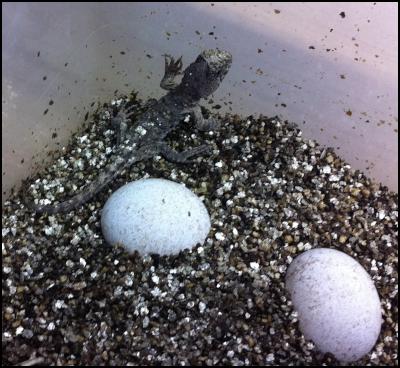11 Precious Baby Tuatara Arrivals
11 Precious Baby Tuatara Arrivals
Rotorua,
17 April 2011 – Ancient stories are hatching at
Rotorua's Rainbow Springs with the recent arrival of 11
precious baby tuataras.
New Zealand's own living dinosaurs are very rarely bred in captivity and the eggs hatched between 30 March and 10 April to proud parents Honey (24) and Bugsy (53,) after a 184-day incubation period. It's Rainbow Springs first hatch of tuatara eggs and believed to be one of the largest clutch of eggs to successfully hatch in captivity in New Zealand.
"It's been a slow and painstaking wait for the arrival of the baby tuataras after such a long incubation period, especially after a previous clutch of eggs never hatched. It was truly amazing to see 11 healthy baby tuataras emerge over the last few weeks. We couldn't believe it, they just kept on popping out," says Michelle Caldwell, General Manager, Rainbow Springs Kiwi Wildlife Park.
"It's very special to see such an iconic New Zealand reptile hatching, especially when tuataras are on the list of New Zealand's endangered species. Rainbow Springs is very excited to do its part for the conservation of the tuatara."
The baby tuataras are in isolation for the next few weeks gaining strength before moving out into a bigger enclosure, and Rainbow Springs staff say they are off to a great start displaying healthy eating and hunting instincts, feeding on a staple diet of flies, larvae and locusts. The public will have a chance for their first look in about six months time.
While the sex of the new arrivals hasn't yet been determined, as with other reptiles the warmer the soil around the eggs, the greater the chance they will be males and the cooler the soil, the greater the chance they will be females. With further breeding in mind Rainbow Springs is hoping for a mix of both sexes.
The nocturnal tuatara is an ancient reptile which roamed the earth the same time as dinosaurs more than 225 million years ago. Its relatives died out about 60 million years ago which is why tuataras are sometimes called a ' living fossil'.

Tuatara
facts:
Tuatara have the po11tial to live up to 300
years in the right conditions. The average life span is 80 -
100 years. The oldest in captivity is Henry who is 120 - 130
years old in the Tuatarium at Invercargill.
Only once every two to five years will the female be ready to mate. The male will sit outside her burrow and wait. If she is interested they will mate and 8 or 9 months later she will lay and bury 6 to 10 eggs in a sunny place. 11 to 16 months later the baby tuatara will hatch.
Tuatara take 35 years to grow to their full size of 600mm (24 inches or 2ft). They also have the longest incubation period of any reptile with eggs taking up to 15 months to hatch.
The Tuatara is an unblinking reptile with a thick scaly skin.
This
small ‘dragon’ also has irregular spines descending from
the back of the head and down along the ridged back. The
Tuatara are nocturnal animals who also appear sluggish
during the hours of darkness.
In cooler temperatures
during winter their metabolism slows down to 10 heart beats
per min and 1 breath per hour. During this time, because
their metabolism has slowed they don't require food. They
can survive without eating for a year!
Tuatara are
‘stand-and wait’ carnivores that snatch almost any small
animal straying within reach, including weta, spiders,
skinks, geckos, and even birds and their eggs or
chicks.
Juvenile tuatara are of11 diurnal (active during
the daytime) to avoid being prey for larger (largely
nocturnal) tuatara.
In Māori tuatara means 'spiny back'
and refers to the row of spines down its back.
Rainbow
Springs Kiwi Wildlife Park is an icon of New Zealand tourism
and has been open since 1932. Spread over 22 acres
of Rotorua parkland, Rainbow Springs is a conservation and
breeding haven for endangered New Zealand species such as
Kiwi and tuatara. The park offers a unique wildlife
experience for visitors, who can see animals in their
natural environment, both during the day and night.
Features of the award winning tourist attraction include New
Zealand's only 'open to view' Kiwi hatchery, and a range of
wildlife including trout, tuatara and native birds.
Rainbow Springs, Fairy Springs Road,
Rotorua.


 Business Canterbury: Urges Council To Cut Costs, Not Ambition For City
Business Canterbury: Urges Council To Cut Costs, Not Ambition For City Wellington Airport: On Track For Net Zero Emissions By 2028
Wellington Airport: On Track For Net Zero Emissions By 2028 Landcare Research: ANZAC Gall Fly Release Promises Natural Solution To Weed Threat
Landcare Research: ANZAC Gall Fly Release Promises Natural Solution To Weed Threat NZ Anti-Vivisection Society: Auckland Rat Lovers Unite!
NZ Anti-Vivisection Society: Auckland Rat Lovers Unite! University of Canterbury: $1.35 Million Grant To Study Lion-like Jumping Spiders
University of Canterbury: $1.35 Million Grant To Study Lion-like Jumping Spiders Federated Farmers: Government Ends War On Farming
Federated Farmers: Government Ends War On Farming



